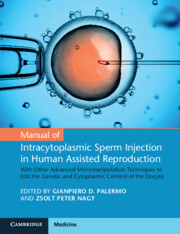 Manual of Intracytoplasmic Sperm Injection in Human Assisted Reproduction
Manual of Intracytoplasmic Sperm Injection in Human Assisted Reproduction Published online by Cambridge University Press: 02 December 2021
Since its inception, ICSI has become the most widely used ART technique, and the ultimate treatment for severe male factor infertility. In this chapter, we provide fertilization and clinical pregnancy outcomes with ICSI utilizing oligo-, crypto- and astheno- zoospermic samples. We also describe the negative impact of ooplasmic dysmaturity on fertilization and propose methods to correct it. We also report the selection of spermatozoa with higher genomic integrity using a microfluidic chip in couples with high chromatin fragmentation and complete embryo aneuploidy. This will be followed by a discussion on the safety of ICSI in which we enlist various follow-up studies on the development and health of ICSI offspring through adulthood. To provide an overview on the widespread utilization of this procedure, we comment on the ICSI results reported worldwide.
To save this book to your Kindle, first ensure [email protected] is added to your Approved Personal Document E-mail List under your Personal Document Settings on the Manage Your Content and Devices page of your Amazon account. Then enter the ‘name’ part of your Kindle email address below. Find out more about saving to your Kindle.
Note you can select to save to either the @free.kindle.com or @kindle.com variations. ‘@free.kindle.com’ emails are free but can only be saved to your device when it is connected to wi-fi. ‘@kindle.com’ emails can be delivered even when you are not connected to wi-fi, but note that service fees apply.
Find out more about the Kindle Personal Document Service.
To save content items to your account, please confirm that you agree to abide by our usage policies. If this is the first time you use this feature, you will be asked to authorise Cambridge Core to connect with your account. Find out more about saving content to Dropbox.
To save content items to your account, please confirm that you agree to abide by our usage policies. If this is the first time you use this feature, you will be asked to authorise Cambridge Core to connect with your account. Find out more about saving content to Google Drive.